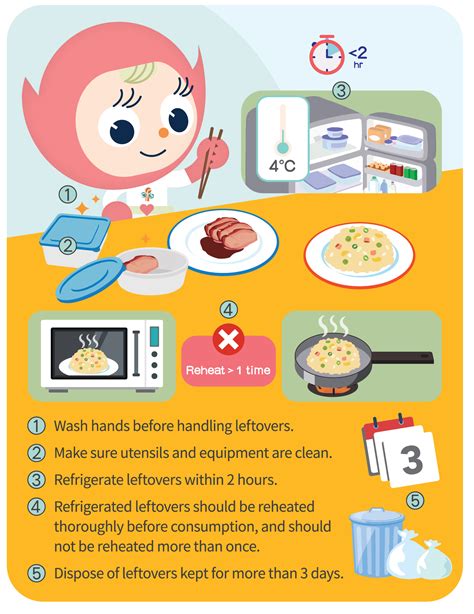
Reheating leftovers incorrectly can create a breeding ground for bacteria, potentially leading to food poisoning, warn food safety experts. Thoroughly reheating food to the correct internal temperature is crucial to eliminate harmful microorganisms and prevent illness, according to official guidelines. Skipping this essential step puts individuals at risk of consuming food contaminated with dangerous bacteria, even if the food looked and smelled fine.
The dangers lurking in leftover containers often go unnoticed, making proper reheating techniques vital for food safety. Experts emphasize that merely warming food is insufficient; it must be heated to a temperature that kills harmful bacteria that may have grown during storage. These bacteria, such as Bacillus cereus and Clostridium perfringens, can multiply rapidly in improperly stored leftovers, producing toxins that cause vomiting, diarrhea, and other unpleasant symptoms.
The Risks of Improper Reheating
Leftovers are a convenient way to enjoy meals for a second time, reducing food waste and saving time. However, if not handled correctly, they can pose a significant health risk. The primary danger lies in the potential for bacterial growth, which occurs when food is left at room temperature for more than two hours. Once bacteria multiply to unsafe levels, reheating may not always eliminate the toxins they produce.
According to the U.S. Department of Agriculture (USDA), certain bacteria thrive in leftover food, including:
- Bacillus cereus: Commonly found in cooked rice and pasta, Bacillus cereus can produce toxins that cause vomiting and diarrhea. These toxins are heat-stable, meaning they can survive even after reheating.
- Clostridium perfringens: This bacterium grows rapidly in cooked meats, poultry, and gravies that are left at room temperature. It produces a toxin that causes abdominal cramps and diarrhea.
- Staphylococcus aureus: Often found on the skin and in the nasal passages, Staphylococcus aureus can contaminate food through improper handling. It produces a heat-stable toxin that causes nausea, vomiting, and diarrhea.
- E. coli: Certain strains of E. coli can cause severe food poisoning, leading to diarrhea, abdominal cramps, and vomiting.
- Salmonella: Commonly found in raw poultry, eggs, and meat, Salmonella can contaminate cooked foods if they are not handled properly. It causes diarrhea, fever, and abdominal cramps.
“When reheating leftovers, the goal is to kill any bacteria that may have grown while the food was cooling and being stored,” explains Dr. Meredith Carothers, a food safety expert at the USDA. “Heating food to the proper internal temperature is the best way to achieve this.”
The Importance of Internal Temperature
The key to safe reheating is reaching a sufficient internal temperature that destroys harmful bacteria. The USDA recommends reheating leftovers to an internal temperature of 165°F (74°C). This temperature is high enough to kill most bacteria that can cause food poisoning.
To ensure food reaches this temperature, it’s essential to use a food thermometer. Insert the thermometer into the thickest part of the food, away from bones or fatty areas, to get an accurate reading. “Using a food thermometer is the only reliable way to ensure that leftovers have reached a safe internal temperature,” Dr. Carothers emphasizes.
Different methods of reheating can affect how evenly the food is heated. Microwave ovens, for example, can create hot spots and cold spots. Therefore, it’s crucial to stir the food periodically during reheating to distribute heat evenly.
Safe Reheating Methods
Several methods can be used to reheat leftovers safely, each with its own advantages and disadvantages:
- Microwave: Microwaving is a quick and convenient method for reheating leftovers. However, it’s important to stir the food periodically to ensure even heating. Cover the food with a microwave-safe lid or plastic wrap to retain moisture and prevent splattering. Ensure the food reaches an internal temperature of 165°F (74°C).
- Oven: Reheating leftovers in the oven can help maintain their texture and flavor. Preheat the oven to 325°F (163°C) and place the leftovers in an oven-safe dish. Add a small amount of liquid, such as water or broth, to prevent the food from drying out. Cover the dish with foil and bake until the food is heated through, reaching an internal temperature of 165°F (74°C).
- Stovetop: Reheating leftovers on the stovetop is a good option for soups, stews, and sauces. Place the food in a saucepan or pot and heat over medium heat, stirring frequently. Ensure the food reaches a rolling boil for at least one minute to kill any bacteria. Use a food thermometer to verify that the internal temperature reaches 165°F (74°C).
- Air Fryer: Air fryers are becoming increasingly popular for reheating leftovers. They can quickly heat food while maintaining a crispy texture. Preheat the air fryer to 350°F (175°C) and place the leftovers in the basket. Cook for several minutes, checking the internal temperature periodically until it reaches 165°F (74°C).
Safe Storage Practices
Proper storage is just as important as proper reheating when it comes to preventing food poisoning from leftovers. Follow these guidelines for safe storage:
- Cool food quickly: Bacteria multiply rapidly at room temperature. Cool leftovers quickly by placing them in shallow containers and refrigerating them within two hours of cooking.
- Store leftovers properly: Store leftovers in airtight containers to prevent contamination and maintain moisture. Label the containers with the date to ensure that you use them within a safe timeframe.
- Use leftovers promptly: The USDA recommends using leftovers within three to four days. After this time, the risk of bacterial growth increases, even if the food looks and smells fine.
- Don’t overcrowd the refrigerator: Overcrowding the refrigerator can prevent proper air circulation, which can slow down the cooling process.
Recognizing Signs of Spoilage
Even if leftovers have been stored properly, it’s essential to check for signs of spoilage before reheating. Common signs of spoilage include:
- Unusual odor: If the leftovers have an off-putting or sour smell, they should be discarded.
- Slimy texture: A slimy or sticky texture can indicate bacterial growth.
- Visible mold: Any signs of mold growth are a clear indication that the food is spoiled.
- Discoloration: Changes in color, such as browning or darkening, can also indicate spoilage.
“When in doubt, throw it out,” advises the USDA. “It’s better to be safe than sorry when it comes to food safety.”
Vulnerable Populations
Certain populations are more vulnerable to food poisoning than others. These include:
- Pregnant women: Food poisoning can have serious consequences for pregnant women and their unborn babies.
- Young children: Children have weaker immune systems and are more susceptible to food poisoning.
- Older adults: Older adults also have weaker immune systems and are more likely to develop complications from food poisoning.
- People with weakened immune systems: Individuals with compromised immune systems, such as those undergoing chemotherapy or living with HIV/AIDS, are at increased risk of food poisoning.
These vulnerable populations should take extra precautions when handling and reheating leftovers to minimize the risk of illness.
Common Mistakes to Avoid
Several common mistakes can increase the risk of food poisoning from leftovers:
- Leaving food at room temperature for too long: Bacteria can multiply rapidly at room temperature. Don’t leave leftovers out for more than two hours.
- Not cooling food quickly enough: Cooling food slowly can allow bacteria to multiply. Divide leftovers into shallow containers to speed up the cooling process.
- Not reheating food to a sufficient temperature: Reheating food to 165°F (74°C) is essential to kill harmful bacteria.
- Not using a food thermometer: A food thermometer is the only reliable way to ensure that leftovers have reached a safe internal temperature.
- Storing leftovers for too long: Leftovers should be used within three to four days.
Expert Recommendations
Food safety experts offer the following recommendations for handling and reheating leftovers safely:
- Always wash your hands: Wash your hands thoroughly with soap and water before handling food.
- Use clean utensils and cutting boards: Prevent cross-contamination by using clean utensils and cutting boards.
- Cook food to the proper internal temperature: Use a food thermometer to ensure that food is cooked to a safe internal temperature.
- Cool leftovers quickly: Divide leftovers into shallow containers and refrigerate them within two hours of cooking.
- Store leftovers properly: Store leftovers in airtight containers and label them with the date.
- Reheat leftovers to 165°F (74°C): Use a food thermometer to ensure that leftovers have reached a safe internal temperature.
- Discard leftovers after three to four days: Leftovers should be used within three to four days to minimize the risk of bacterial growth.
- When in doubt, throw it out: If you’re unsure whether leftovers are safe to eat, discard them.
By following these guidelines, individuals can significantly reduce their risk of food poisoning from leftovers and enjoy their meals with confidence.
The Role of Public Health Agencies
Public health agencies, such as the USDA and the FDA, play a crucial role in educating the public about food safety. These agencies provide resources and guidelines on safe food handling, storage, and preparation practices. They also monitor foodborne illness outbreaks and work to identify the sources of contamination.
The USDA’s Food Safety and Inspection Service (FSIS) is responsible for ensuring that meat, poultry, and processed egg products are safe, wholesome, and correctly labeled. The FDA is responsible for regulating all other food products, including seafood, fruits, vegetables, and dairy products.
These agencies work together to protect the public from foodborne illnesses by providing information, conducting inspections, and enforcing regulations. They also collaborate with industry partners to promote food safety best practices.
Advances in Food Safety Technology
Technological advancements are playing an increasingly important role in improving food safety. New technologies, such as rapid pathogen detection systems and advanced packaging materials, are helping to prevent foodborne illnesses.
Rapid pathogen detection systems can quickly identify the presence of harmful bacteria in food samples, allowing for faster response times and more effective interventions. Advanced packaging materials can help to extend the shelf life of food products and prevent contamination.
These technologies are helping to make the food supply safer and more secure. As technology continues to advance, it is likely to play an even greater role in preventing foodborne illnesses in the future.
Conclusion
Reheating leftovers safely is a critical step in preventing food poisoning. By following proper storage and reheating practices, individuals can minimize their risk of illness and enjoy their meals with confidence. Remember to cool leftovers quickly, store them properly, reheat them to 165°F (74°C), and use a food thermometer to ensure that they have reached a safe internal temperature. When in doubt, throw it out. Prioritizing food safety is essential for protecting public health and preventing foodborne illnesses.
Frequently Asked Questions (FAQs)
1. Why is it important to reheat leftovers to 165°F (74°C)?
Reheating leftovers to an internal temperature of 165°F (74°C) is crucial because this temperature kills most harmful bacteria that may have grown in the food during storage. Bacteria like Bacillus cereus and Clostridium perfringens can multiply at room temperature and produce toxins that cause food poisoning. Heating to this temperature ensures these bacteria are eliminated, reducing the risk of illness.
2. How quickly should leftovers be cooled and refrigerated?
Leftovers should be cooled as quickly as possible and refrigerated within two hours of cooking. Bacteria multiply rapidly at room temperature, so prompt cooling is essential to minimize their growth. Divide leftovers into shallow containers to speed up the cooling process and ensure they reach a safe temperature in the refrigerator quickly.
3. What are the best methods for reheating leftovers safely?
Several methods can be used to reheat leftovers safely, including:
- Microwave: Stir the food periodically to ensure even heating and cover it to retain moisture.
- Oven: Preheat the oven to 325°F (163°C) and add a small amount of liquid to prevent drying.
- Stovetop: Heat soups, stews, and sauces over medium heat, stirring frequently, and ensure they reach a rolling boil for at least one minute.
- Air Fryer: Preheat the air fryer to 350°F (175°C) and check the internal temperature periodically.
Regardless of the method, always use a food thermometer to ensure the internal temperature reaches 165°F (74°C).
4. How long can leftovers be safely stored in the refrigerator?
The USDA recommends using leftovers within three to four days. After this time, the risk of bacterial growth increases, even if the food looks and smells fine. Label containers with the date to help track how long leftovers have been stored.
5. What are the signs of spoilage to look for before reheating leftovers?
Before reheating leftovers, check for the following signs of spoilage:
- Unusual odor: An off-putting or sour smell.
- Slimy texture: A slimy or sticky texture can indicate bacterial growth.
- Visible mold: Any signs of mold growth.
- Discoloration: Changes in color, such as browning or darkening.
If any of these signs are present, discard the leftovers immediately. “When in doubt, throw it out,” advises the USDA.









